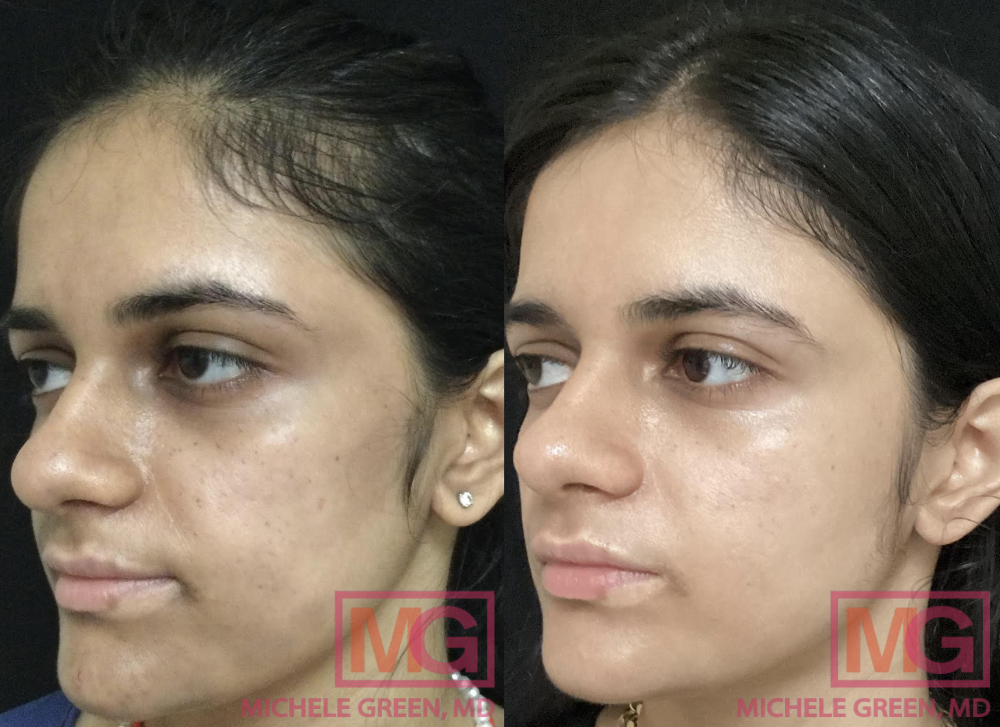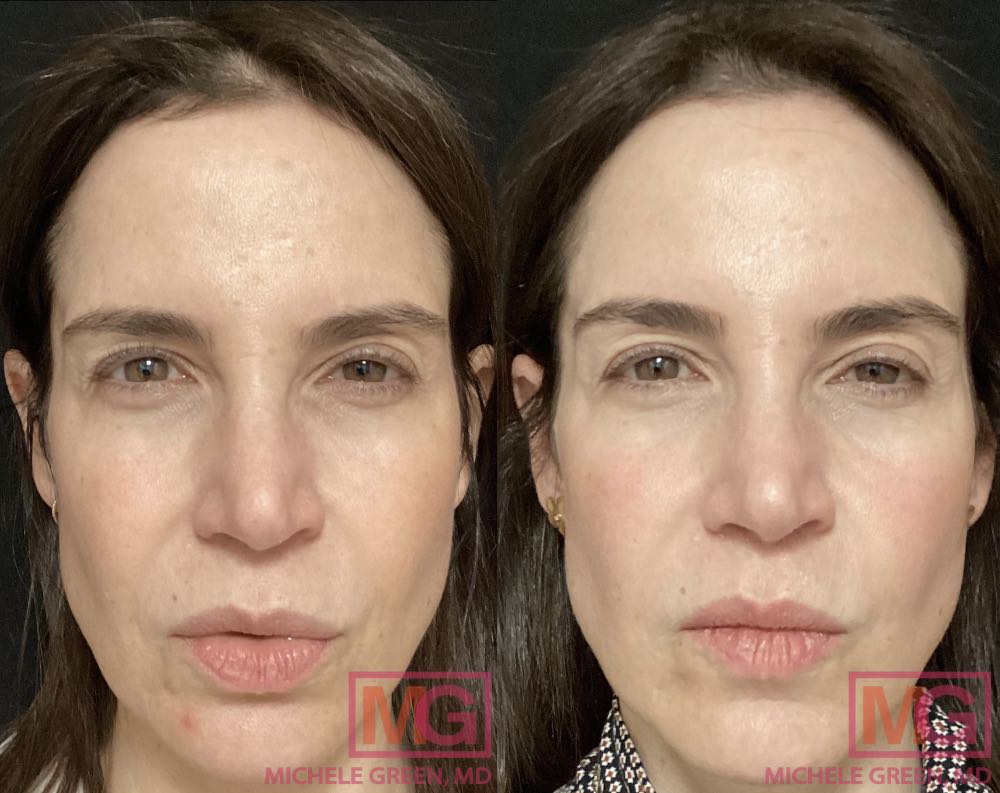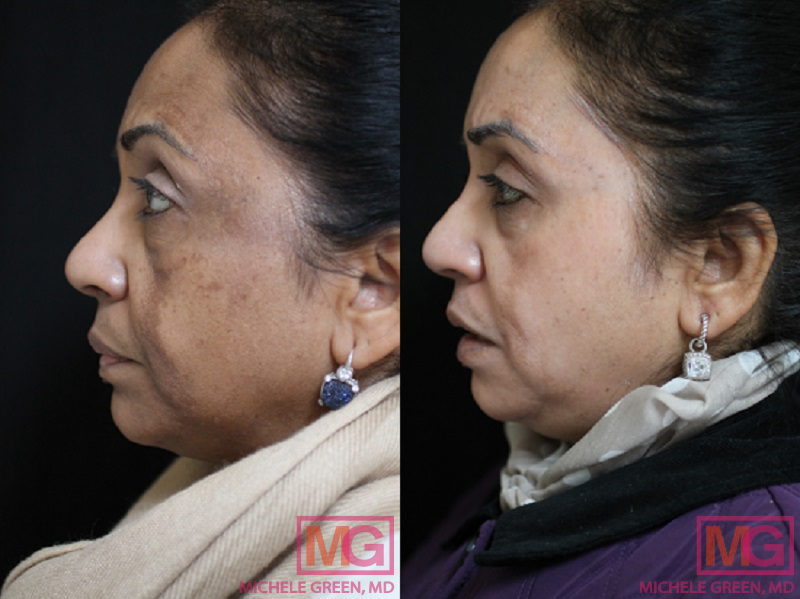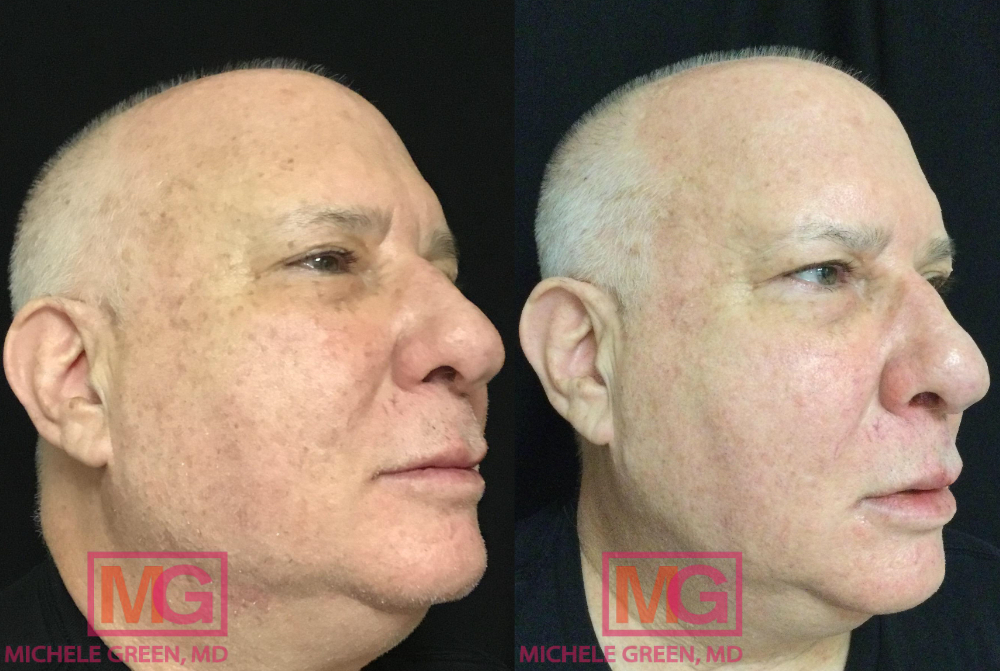Chemical Peels for Freckles
For some, the appearance of freckles, little brown spots most commonly found on the nose, cheeks, forehead, shoulders, and hands, can be welcome aesthetically. Still, these small, highly visible blemishes can be frustrating for others. Caused by high sun exposure, freckles appear most commonly in those with light skin who are more susceptible to sun damage, often becoming more prominent at the end of the summer and fading during winter time. Luckily, those who are self-conscious about the appearance of freckles on the face or body can turn to chemical peel treatment available at board-certified dermatologist Dr. Michele Green’s New York City office.
Ranked among the top five most popular non-invasive cosmetic procedures in the United States, chemical peels are highly effective at rejuvenating the skin and reducing the appearance of pigmentation. Chemical peels are composed of a chemical solution that, when applied to the skin’s surface, reacts with the debris and dead skin cells, exfoliating the epidermis and boosting skin cell turnover and collagen production. The resurfacing treatment results in smoother skin texture, improved skin tone, and lightening of dark spots and hyperpigmentation. Chemical peels can be composed of many different acids at various strengths and concentrations, with light or superficial chemical peels for gentle exfoliation to deep chemical peels that penetrate the deeper dermal layers of skin. When it comes to eliminating the appearance of freckles, chemical peels are a highly effective treatment option to lighten the skin, providing skin-lightening results with no downtime necessary.
To achieve the best results from a chemical peel treatment, it is best to seek out an experienced, board-certified dermatologist, such as Dr. Michele Green. Dr. Green has been expertly treating patients in her Upper East Side New York City dermatology office for more than 25 years. With a wide range of treatment options available at her office, Dr. Green can treat patients of all skin types for any cosmetic concern. When it comes to choosing a chemical peel, Dr. Green is a master in finding the type of chemical peel that will be safest and most effective for your skin tone and cosmetic concern. Chemical peel treatment can also be paired with other treatment options, including laser treatment, for improved results. Dr. Green is well-known for high patient satisfaction and has been frequently voted one of the best healthcare providers in New York City by such publications as New York Magazine, Castle Connolly, and Super Doctors.
What is a chemical peel?
Chemical peels are a very popular, highly effective cosmetic procedure to exfoliate the skin to promote the production of new skin cells and the structural protein collagen. This non-invasive treatment involves the topical application of a chemical solution to improve the texture and tone of the skin, resulting in smoother, brighter, more evenly-colored skin. Chemical peels can be used to treat various skin conditions and concerns, including fine lines and wrinkles, melasma, sun spots, age spots, rosacea, acne, acne scars, clogged pores, hyperpigmentation or discoloration, irregular skin texture, and freckles.
Many different types of acid peels range in the chemical solution used and the concentration of the acid. When distinguishing types of chemical peels, there are three overarching categories: light chemical peels (or superficial peels), medium-depth peels, and deep chemical peels. Superficial peels are the gentlest kind of chemical peels, working to resurface only the outer layer of skin (the epidermis) to improve fine lines, treat minor acne, reduce oily skin, and brighten small dark spots, such as freckles. The main types of light chemical peels are alpha hydroxy acid peels, such as glycolic acid peels, beta hydroxy acid peels, such as salicylic acid peels, and Jessner’s peels, which contain lactic acid. Medium-depth peels, such as trichloroacetic acid (TCA) peels, are more powerful and penetrate the dermal layer of skin, making them effective for treating deeper lines and wrinkles, acne scars, and hyperpigmentation. Deep peels, such as phenol peels, are the most powerful type of chemical peel, penetrating the deeper dermis to treat deep wrinkles, hyperpigmentation, and pre-cancerous lesions. Due to the powerful nature of deep chemical peels, patients with darker skin should avoid this type of peel, as it can cause side effects such as post-inflammatory hyperpigmentation. Deep chemical peels also require longer recovery time post-treatment.

How does a chemical peel work?
Chemical peels work via the topical application of a chemical solution composed of different kinds of acids, which react with the dead skin cells and debris on the outer layer of the skin to exfoliate the skin. Depending on the depth of the peel, the acid solution can penetrate the dermal layer of the skin to stimulate deeper epidermal regeneration. The interaction between the chemical solution and the skin cause controlled damage to the epidermis and dermis, which triggers the body’s healing response and leads to the growth of new skin cells, resulting in brighter, more evenly textured skin. The new layer of skin that appears as a result of the resurfacing also improves skin tone, reducing the appearance of discoloration and hyperpigmentation, including the freckles and age spots resulting from sun exposure and sun damage.
What causes freckles?
Freckles, which are benign dark spots, are found primarily on areas of the skin that have often been exposed to the sun. The development of freckles is most common in people with light skin that are more susceptible to sunburn and other forms of sun damage. When areas of the skin are exposed to the sun’s UV rays without sunscreen protection, melanin production increases in these areas. Melanin is the pigmentation produced by cells called melanocytes that gives color to the skin and hair. When the skin is exposed to the sun, the production of melanin will increase in the affected area, as melanin helps to protect the skin against UV rays that can damage DNA. This is why patients will often see an increase in the prevalence of freckles at the end of a summer spent outside, and freckles will go away or fade considerably during winter months spent largely indoors. The best way to prevent the appearance of freckles is to practice strict sun avoidance by staying inside when the sun is at its most intense – between 10 am and 2 pm – and wearing sunscreen of at least SPF 30 anytime you go outside, even when the UV index is low.
Will chemical peels remove freckles?
One of the best solutions for patients looking to remove freckles is to turn to chemical peels. Chemical peels reduce discoloration and hyperpigmentation on the skin by exfoliating pigmented skin cells at the treatment site. When the chemical peel is applied to the area of the face or body with freckles, the chemical solution resurfaces the skin, improving skin tone and reducing the appearance of freckles. Several different types of chemical peels work to remove freckles. When you have your initial consultation with Dr. Green, she will examine the treatment area and consider your skin type before determining the type of chemical peel that will be the safest and most effective for you.
Does lactic acid remove freckles?
A lactic acid peel is an effective chemical peel that reduces the appearance of freckles and is good for sensitive skin. A type of alpha hydroxy acid peel, the lactic acid peel is typically used as a superficial peel that hydrates, brightens the skin, and eliminates dark spots. Lactic acid is naturally found in dairy products and has been used as a natural skincare ingredient for a long time. A key ingredient in Jessner’s Peel, lactic acid peels are typically safe for patients of all skin types, and the risk of side effects is low.
Will glycolic acid remove freckles?
One of the most popular types of alpha hydroxy acid peels is the glycolic acid peel, which works well to reduce the appearance of fine lines, minor acne, skin texture irregularities, and freckles. Glycolic acid is derived from sugar cane and is used as an active ingredient in superficial chemical peels. Glycolic acid peels are effectively used to brighten the skin and remove freckles without requiring significant recovery time. The potential side effects are minimal, including dry skin, redness, or flaking. Any side effects from glycolic acid peels can be mitigated with a gentle cleanser and rich moisturizer.
What is a TCA peel for removing freckles?
Trichloroacetic acid peels, also known as TCA peels, are medium-depth peels that work well to reduce the appearance of freckles. TCA peels serve many functions in cosmetic dermatology. In addition to removing hyperpigmentation such as freckles, age spots, and discoloration, the TCA peel is highly effective at reducing the appearance of atrophic acne scars. TCA peels can be used at different concentrations to penetrate the deeper layers of the dermis if necessary. Still, TCA peels should be avoided at higher concentrations for patients with darker skin as there is a higher risk of developing post-inflammatory hyperpigmentation. According to a study published in 2012 that compared the effects of a 70% TCA peel and an 80% phenol peel, 75% percent of patients saw a complete clearance of all freckles in the treatment area (a 90-100% reduction in visibility of freckles).

Which chemical peel is best for freckles?
Several different types of chemical peels work well to remove freckles, including a lactic acid peel, glycolic acid peel, TCA peel, and phenol peel. No one chemical peel is inherently “better” than another, rather, it depends on the severity of the discoloration, the sensitivity of the patient’s skin, and skin tone. For patients with light discoloration, sensitive skin, and/or darker skin, a superficial chemical peel, such as the lactic acid peel or the glycolic acid peel, may be the best option to make the freckles go away without harming the skin. For more severe hyperpigmentation, a more concentrated chemical peel, such as the TCA or the phenol peel, may be the best option to resurface and exfoliate the skin. In a study performed in 2012, researchers examined the effectiveness of a 70% TCA peel compared to an 80% phenol peel in removing freckles. The study showed that both types of chemical peels were highly effective in reducing the appearance of freckles on the face, with 75% of all patients seeing a 90-100% reduction in the prevalence of freckles.
Should you get IPL or chemical peels for freckles?
Intense Pulsed Light, also known as IPL, photo-rejuvenation, or a photo-facial, is a treatment option that reduces the appearance of discoloration or hyperpigmentation on the skin. While most laser treatments focus a single beam of energy on the treatment area, IPL uses multiple different wavelengths of light to address various concerns that develop from the natural aging process, including sunspots, scars, and rosacea. When the wavelengths of light are emitted from the IPL device, the light is absorbed by the melanin-rich blemishes on the skin and converted into heat energy, which then destroys the pigmented cells. IPL is a very effective treatment for eliminating the appearance of freckles and is an additional treatment option for cases of discoloration on the skin. IPL is a painless procedure that requires no recovery time following treatment, meaning patients can immediately return to their regularly scheduled activities.
Will a chemical peel remove dark spots?
Dark spots occur on the skin when there is an increased production of melanin, which several factors, including overexposure to the sun, hormone fluctuations, genetic predisposition, and acne scarring, can cause. Regardless of the cause of the dark spot, chemical peels are a great treatment option for eliminating hyperpigmentation on the face or body. Chemical peels of varying depths can be used to treat dark spots, and when deciding which to use, it is best to consult an expert dermatologist, such as Dr. Green.
Which chemical peel is best for dark spots?
One of the best options for treating dark spots on the skin is to use a Cosmelan peel, which contains a proprietary combination of ingredients designed specifically to reduce discoloration on the skin, such as hyperpigmentation and melasma. The peel works on several levels to reduce discoloration on the skin by decreasing the production of the pigmentation melanin and inhibiting the movement of melanin from the melanocytes where the pigment is produced. As a result, the appearance of melasma or dark spots is reduced on the skin’s surface. The procedure is simple to perform: when patients arrive in the office, Dr. Green will apply the chemical solution to the skin, where it will sit for several hours. At home, patients can remove the solution with a gentle cleanser and, in the next couple of days, will experience peeling of the skin while the exfoliation occurs, leaving brighter, more evenly toned skin.

Will a chemical peel remove age spots?
Age spots, also known as sun spots or liver spots, are a common development due to the natural aging process and occur due to overexposure to the sun’s harmful UV rays. When time is spent outside without the protection of sunscreen or clothing, sun damage can occur on the skin. The body reacts to sun exposure by increasing the production of the pigment melanin, which helps protect the skin from further damage but leaves dark spots on the skin’s surface. Age spots develop on the areas of the body that are most often exposed to the sun, including the face, backs of the hands, arms, and shoulders. Chemical peels are an effective solution for eliminating the appearance of age spots by resurfacing the skin for a more even skin tone. Several types of chemical peels can work on age spots; Dr. Green often uses a TCA peel or glycolic acid peel for the best results.
Is a chemical peel good for hyperpigmentation?
Hyperpigmentation is the name for the skin condition in which dark spots appear on the surface of the skin and can be caused by many factors, including sun damage, hormone fluctuations, genetic predisposition, medication, or as a reaction to a cosmetic procedure. Chemical peels are a highly effective treatment option for hyperpigmentation. Many different types of chemical peels can be used, including glycolic acid peels, lactic acid peels, TCA peels, Cosmelan peels, and phenol peels. For areas with sensitive skin where hyperpigmentation has occurred, such as under the arms or in the genital area, the Mesopeel can be used to exfoliate the skin and reduce hyperpigmentation gently.
What is the proper skin care following a chemical peel treatment?
When receiving chemical peel treatment, taking care of your skin by keeping it hydrated and practicing strict sun avoidance is vital. Chemical peels often work to dry out the skin, which can lead to redness and irritation. Dr. Green recommends that patients apply a gentle cleanser and rich moisturizer throughout the treatment process to keep irritation and bay and keep the skin hydrated. Further, following a chemical peel treatment, the skin will be more sensitive to the sun, making it doubly important to protect it from the sun. Patients should practice strict sun avoidance by staying inside when the sun is at its most intense and wearing protective clothing and sunscreen of at least SPF 30 when going outside. During your consultation appointment, Dr. Green can advise on other skincare products to be used before or after treatment to help keep skin healthy and to help with skin-lightening. Retinoids can help reduce the appearance of freckles with their skin-lightening properties. However, the use of retinoids should be stopped in the weeks leading up to chemical peel treatment to avoid further irritation to the skin.

How do I get started with chemical peels for freckles today?
Freckles may be pleasing to some, but they are a nuisance to others. While these small dark spots are benign, they can make some people feel self-conscious, causing them to look for a way to eliminate the appearance of freckles on their faces or body. For those patients, look no further than the chemical peel treatment available at Dr. Michele Green’s New York City dermatology office. With many different types of chemical peels to choose from, including the lactic acid peel, glycolic acid peel, TCA peel, and phenol peel, knowing which peel is best can feel overwhelming. Luckily, Dr. Green is an expert at choosing the chemical peel that will be the safest and most effective for you.
Dr. Michele Green is an internationally renowned board-certified cosmetic dermatologist with over two and a half decades of experience providing some of the most discerning individuals around the globe with the best non-invasive treatment options available, including chemical peels. Castle Connolly, Super Doctors, New York Magazine, and The New York Times consistently identify Dr. Green as one of New York City’s best dermatologists for her dedication to her patients and expertise. Dr. Green takes a holistic approach and embraces a less-is-more philosophy when it comes to facial rejuvenation, customizing the treatment plan of each patient to suit perfectly their unique needs and personal aesthetic goals. If you are looking for the best chemical peel treatment in New York for eliminating freckles, please call our office at 212-535-3088 or contact us online to schedule a consultation with Dr. Green today.
 212-535-3088
212-535-3088